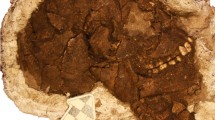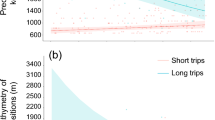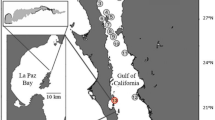Abstract
This study examines variation in brain growth relative somatic growth in four hominoids and three platyrrhines to determine whether there is a trade-off during ontogeny. I predicted that somatic growth would be reduced during periods of extensive brain growth, and species with larger degrees of encephalization would reach a smaller body size at brain growth completion because more energy is directed towards the brain. I measured cranial capacity and skeletal size in over 500 skeletal specimens from wild populations. I calculated nonlinear growth curves and velocity curves to determine brain/body growth allometry during ontogeny. In addition, I calculated linear regressions to describe the brain/body allometry during the postnatal period prior to brain size reaching an asymptote. The results showed that somatic growth is not substantially reduced in species with extensive brain growth, and body size at brain growth completion was larger in species with greater degrees of encephalization. Furthermore, large body size at brain growth completion was not correlated with interbirth interval, but was significantly correlated with prolonged juvenile periods and late age at maturity when data were corrected for phylogeny. These results indicate that neither reduction in body growth nor reproductive rate are compensatory mechanisms for the energetic costs of brain growth. Other avenues for meeting energetic costs must be in effect. In addition, the results show that somatic growth in encephalized species is particularly slow during the juvenile period after brain growth at or near completion, suggesting that these growth patterns are explained by reasons other than energetic costs.




Similar content being viewed by others
References
Aiello, L., Bates, N., & Joffe, T. (2001). In defence of the expensive tissue hypothesis. In D. Falk & K. R. Gibson (Eds.), Evolutionary anatomy of the primate cerebral cortex (pp. 57–78). Cambridge: Cambridge University Press.
Aiello, L., & Wheeler, P. (1995). The expensive-tissue hypothesis. Current Anthropology, 36(2), 199–221.
Barrickman, N. L. (2008). Evolutionary relationship between life history and brain growth in anthropoid primates. Ph.D. Dissertation, Duke University, Durham, North Carolina.
Barrickman, N. L., Bastian, M. L., Isler, K., & van Schaik, C. P. (2008). Life history costs and benefits of encephalization: A comparative test using data from long-term studies of primates in the wild. Journal of Human Evolution, 54(5), 568–590.
Barrickman, N. L., & Lin, M. J. (2010). Encephalization, expensive tissue, and energetics: An examination of the relative costs of brain size in strepsirrhines. American Journal of Physical Anthropology, 143, 579–590.
Barton, R. A., & Capellini, I. (2011). Maternal investment, life histories, and the costs of brain growth in mammals. Proceedings of the National Academy of Sciences of the United States of America, 108(15), 6169–6174.
Bielby, J., Mace, G. M., Bininda-Emonds, O. R. P., Cardillo, M., Gittleman, J. L., Jones, K. E., et al. (2007). The fast-slow continuum in mammalian life history: An empirical reevaluation. American Naturalist, 169(6), 748–757.
Bogin, B. (2012). The evolution of human growth. In N. Cameron & B. Bogin (Eds.), Human growth and development (2nd ed., pp. 287–324). London: Elsevier.
Bosson, C. O., Islam, Z., & Boonstra, R. (2012). The impact of live trapping and trap model on the stress profiles of North American red squirrels. Journal of Zoology, 288, 159–169.
Byrne, R. W. (1997). The technical intelligence hypothesis: An additional evolutionary stimulus to intelligence. In A. Whiten & R. Byrne (Eds.), Machiavellian intelligence II (pp. 289–311). Cambridge: Cambridge University Press.
Cabana, T., Jolicoeur, P., & Baron, G. (1990). Brain and body growth and allometry in the Mongolian gerbil (Meriones unguiculatus). Growth, Development, and Aging, 54, 23–30.
Charnov, E., & Berrigan, D. (1993). Why do female primates have such long lifespans and so few babies? Or life in the slow lane. Evolutionary Anthropology, 1, 191–194.
Chugani, H. T., & Phelps, M. E. (1986). Maturational changes in cerebral function in infants determined by 18FDG positron emission tomography. Science, 231(4740), 840–843.
Chugani, H. T., Phelps, M. E., & Mazziotta, J. C. (1987). Positron emission tomography study of human brain functional development. Annals of Neurology, 22(4), 487–497.
Count, E. (1947). Brain and body weight in man: Their antecedents in growth and evolution. Annals of the New York Academy of Science, 46, 993–1122.
Deacon, T. (1990). Problems of ontogeny and phylogeny in brain size evolution. International Journal of Primatology, 11, 237–282.
Deaner, R., Barton, R., & van Schaik, C. P. (2003). Primate brains and life histories: Renewing the connection. In P. Kappeler & M. Pereira (Eds.), Primate life histories and socioecology (pp. 233–265). Chicago: University of Chicago Press.
DeSilva, J. M., & Lesnick, J. J. (2008). Brain size at birth throughout human evolution: A new method for estimating neonatal brain size in hominins. Journal of Human Evolution, 55(6), 1064–1074.
Dunbar, R. I. M. (1998). The social brain hypothesis. Evolutionary Anthropology, 6(5), 178–190.
Felsenstein, J. (1985). Phylogenies and the comparative method. American Naturalist, 125(1), 1–15.
Fish, J. L., & Lockwood, C. A. (2003). Dietary constraints on encephalization in primates. American Journal of Physical Anthropology, 120(2), 171–181.
Garland, T., & Ives, A. (2000). Using the past to predict the present: Confidence intervals for regression equations in phylogenetic comparative methods. American Naturalist, 155, 346–364.
Garland, T., Midford, P., & Ives, A. (1999). An introduction to phylogenetically-based statistical methods, with a new method for confidence intervals on ancestral states. American Zoologist, 39, 374–388.
Gibson, K. (1986). Cognition, brain size and the extraction of embedded food resources. In J. Else & P. Lee (Eds.), Primate ontogeny, cognition, and social behavior (pp. 93–103). New York: Cambridge University Press.
Glander, K. E. (2013). Darting, anesthesia, and handling. In E. J. Sterling, N. Bynum, & M. E. Blair (Eds.), Primate ecology and conservation: A handbook of techniques (pp. 27–39). Oxford: Oxford University Press.
Gould, S. J. (1966). Allometry and size in ontogeny and phylogeny. Biological Reviews of the Cambridge Philosophical Society, 41, 587–640.
Gould, S. J. (1977). Ontogeny and phylogeny. Cambridge: Belknap Press of Harvard University Press.
Harvey, P., Martin, R. D., & Clutton-Brock, T. (1987). Life histories in comparative perspective. In B. Smuts, D. Cheney, R. Seyfarth, R. Wrangham, & T. Struhsaker (Eds.), Primate societies (pp. 181–196). Chicago: University of Chicago Press.
Harvey, P., & Pagel, M. (1991). The comparative method in evolutionary biology. Oxford: Oxford University Press.
Herndon, J. G., Tigges, J., Anderson, D. C., Klumpp, S. A., & McClure, H. M. (1999). Brain weight throughout the lifespan of the chimpanzee. Journal of Comparative Neurology, 409, 567–579.
Herre, W. (1959). Domestikation und Stammesgeschichte. In G. Herberer (Ed.), Die Evolution der Organismen (pp. 801–856). Stuttgart: Gustav Fischer.
Holliday, M. (1986). Body composition and energy needs during growth. In F. Falkner & J. Tanner (Eds.), Human growth: A comprehensive treatise (pp. 101–117). New York: Plenum Press.
Holt, A., Cheek, D., Mellits, E., & Hill, D. (1975). Brain size and the relation of the primate to the nonprimate. In D. Cheek (Ed.), Fetal and postnatal cellular growth: Hormones and nutrition (pp. 23–44). New York: John Wiley.
Isler, K., Christopher Kirk, E., Miller, J. M. A., Albrecht, G. A., Gelvin, B. R., & Martin, R. D. (2008). Endocranial volumes of primate species: Scaling analyses using a comprehensive and reliable data set. Journal of Human Evolution, 55(6), 967–978.
Isler, K., & van Schaik, C. (2006). Costs of encephalization: The energy trade-off hypothesis tested on birds. Journal of Human Evolution, 51, 228–243.
Isler, K., & van Schaik, C. P. (2009). The expensive brain: A framework for explaining evolutionary changes in brain size. Journal of Human Evolution, 57(4), 392–400.
Isler, K., & van Schaik, C. P. (2014). How humans evolved large brains: Comparative evidence. Evolutionary Anthropology, 23(2), 65–75.
Jerison, H. (1973). Evolution of the brain and intelligence. New York: Academic Press.
Joffe, T. H. (1997). Social pressures have selected for an extended juvenile period in primates. Journal of Human Evolution, 32(6), 593–605.
Jolicoeur, P., & Pirlot, P. (1988). Asymptomatic growth and complex allometry of the brain and body in the white rat. Growth, Development, and Aging, 52, 3–10.
Jungers, W. L., Falsetti, A. B., & Wall, C. E. (1995). Shape, relative size, and size-adjustments in morphometrics. Yearbook of Physical Anthropology, 38, 137–161.
Kaplan, H., Hill, K., Lancaster, J., & Hurtado, A. (2000). A theory of human life history evolution: Diet, intelligence, and longevity. Evolutionary Anthropology, 9, 156–185.
Kennedy, C., & Sokoloff, L. (1957). An adaptation of the nitrous oxide method to the study of the cerebral circulation in children; normal values for cerebral blood flow and cerebral metabolic rate in childhood. The Journal of Clinical Investigation, 36(7), 1130–1137.
Kuzawa, C. W., Chugani, H. T., Grossman, L. I., Lipovich, L., Muzik, O., Hof, P. R., et al. (2014). Metabolic costs and evolutionary implications of human brain development. Proceedings of the National Academy of Sciences of the United States of America, 111(36), 13010–13015.
Lee, P. C. (1996). The meanings of weaning: Growth, lactation, and life history. Evolutionary Anthropology, 5(3), 87–96.
Lee, P. (1999). Comparative ecology of postnatal growth and weaning among haplorrhine primates. In P. Lee (Ed.), Comparative primate socioecology (pp. 111–139). Cambridge: Cambridge University Press.
Leigh, S. R. (1994). Relations between captive and noncaptive weights in anthropoid primates. Zoo Biology, 13, 21–43.
Leigh, S. (2001). Evolution of human growth. Evolutionary Anthropology, 10, 223–236.
Leigh, S. (2004). Brain growth, life history and cognition in primate and human evolution. American Journal of Primatology, 62, 139–164.
Leonard, W., & Robertson, M. (1994). Evolutionary perspectives on human nutrition: The influence of brain and body size on diet and metabolism. American Journal of Human Biology, 6, 77–88.
Leonard, W. R., Snodgrass, J. J., & Robertson, M. L. (2012). Comparative and evolutionary perspectives on human brain growth. In N. Cameron & B. Bogin (Eds.), Human growth and development (2nd ed., pp. 397–413). London: Elsevier.
Leutenegger, V. W. (1970). Beziehungen zwishcen der neugeborenengrosse und dem sexualdimorphismus am becken bei simischen primaten. Folia Primatologia, 12, 224–235.
Martin, R. D. (1981). Relative brain size and basal metabolic rate in terrestrial vertebrates. Nature, 293, 57–60.
Martin, R. D. (1983). Human brain evolution in an ecological context. In 52nd James Arthur lecture on the evolution of the human brain. American Museum of Natural History, New York.
Martin, R. D. (1990). Primate origins and evolution: A phylogenetic reconstruction. Princeton: Princeton University Press.
Martin, R. D. (1996). Scaling of the mammalian brain: The maternal energy hypothesis. News in Physiological Sciences, 11, 149–156.
Martin, R. D., Genoud, M., & Hemelrijk, C. (2005). Problems of allometric scaling analysis: Examples from mammalian reproductive biology. Journal of Experimental Biology, 208, 1731–1747.
Martin, R. D., & Harvey, P. H. (1985). Brain size allometry: Ontogeny and phylogeny. In W. Jungers (Ed.), Size and scaling in primate biology (pp. 147–173). New York: Plenum Press.
McFarlin, S. C., Barks, S. K., Tocheri, M. W., Massey, J. S., Eriksen, A. B., Fawcett, K. W., et al. (2013). Early brain growth cessation in wild Virunga mountain gorillas (Gorilla beringei beringei). American Journal of Primatologist, 75(5), 450–463.
Mink, J. W., Blumenschine, R. J., & Adams, D. B. (1981). Ratio of central nervous system to body metabolism in vertebrates: Its constancy and functional basis. The American Journal of Physiology, 241(3), R203–R212.
Nunn, C. L., & Barton, R. A. (2001). Comparative methods for studying primate adaptation and allometry. Evolutionary Anthropology, 10(3), 81–98.
Pagel, M. D., & Harvey, P. H. (1993). Evolution of the juvenile period in mammals. In M. E. Pereira & L. A. Fairbanks (Eds.), Juvenile primates: Life history, development, and behavior (pp. 28–37). New York: Oxford University Press.
Pelletier, F., Hogg, J. T., & Festa-Bianchet, M. (2004). Effect of chemical immobilization on social status of bighorn rams. Animal Behaviour, 67, 1163–1165.
Pereira, M. E., & Leigh, S. R. (2003). Modes of primate development. In P. M. Kappeler & M. E. Pereira (Eds.), Primate life histories and socioecology (pp. 149–176). Chicago: University of Chicago Press.
Purvis, A., & Webster, A. (1999). Phylogenetically independent comparisons and primate phylogeny. In P. Lee (Ed.), Comparative primate socioecology (pp. 44–70). Cambridge: Cambridge University Press.
Pütter, A. (1920). Studien über physiologische Ähnlichkeit. IV. Wachstumsähnlichkeiten. Pfluegers Archiv für die gesamte Physiologie, 180, 298–340.
Reader, S. M., Hager, Y., & Laland, K. N. (2011). The evolution of primate general and cultural intelligence. Philosophical Transactions of the Royal Society B: Biological Sciences, 366(1567), 1017–1027.
Reader, S. M., & Laland, K. N. (2002). Social intelligence, innovation, and enhanced brain size in primates. Proceedings of the National Academy of Sciences of the United States of America, 99(7), 4436–4441.
Rice, S. H. (2002). The role of heterochrony in primate brain evolution. In N. Minugh-Purvis & K. J. McNamara (Eds.), Human evolution through developmental change (pp. 154–170). Baltimore: Johns Hopkins University Press.
Ross, C., & Jones, K. (1999). Socioecology and the evolution of primate reproductive rates. In P. Lee (Ed.), Comparative primate socioecology (pp. 73–110). Cambridge: Cambridge University Press.
Sacher, G., & Staffeldt, E. (1974). Relation of gestation time to brain weight for placental mammals: Implications for the theory of vertebrate growth. American Naturalist, 108, 593–615.
Schultz, A. H. (1941). The relative size of cranial capacity in primates. American Journal of Physical Anthropology, 28, 273–287.
Schultz, A. H. (1965). The cranial capacity and orbital volume of hominoids according to age and sex. In A. Caso, E. H. Dávalos, S. Genovés, M. Léon-Portilla, & D. Sodi (Eds.), Homenaje a Juan Comas en su 65 aniversairo (pp. 337–357). Mexico City: Editorial Libros de Mexico.
Shultz, S., & Dunbar, R. I. M. (2007). The evolution of the social brain: Anthropoid primates contrast with other vertebrates. Proceedings of the Royal Society B: Biological Sciences, 274(1624), 2429–2436.
Smith, R. J., & Jungers, W. L. (1997). Body mass in comparative primatology. Journal of Human Evolution, 32, 523–559.
van Schaik, C., Barrickman, N., Bastian, M., Krakauer, E., & van Noordwijk, M. (2006). Primate life histories and the role of brains. In K. Hawkes & R. Paine (Eds.), The evolution of human life history (pp. 127–154). Santa Fe: SAR Press.
van Schaik, C. P., & Burkart, J. M. (2011). Social learning and evolution: The cultural intelligence hypothesis. Philosophical Transactions of the Royal Society B: Biological Sciences, 366(1567), 1008–1016.
van Schaik, C. P., Isler, K., & Burkart, J. M. (2012). Explaining brain size variation: From social to cultural brain. Trends in Cognitive Sciences, 16(5), 277–284.
Vinicius, L. (2005). Human encephalization and developmental timing. Journal of Human Evolution, 49, 762–776.
Vrba, E. (1998). Multiphasic growth models and the evolution of prolonged growth exemplified by human brain evolution. Journal of Theoretical Biology, 190, 227–239.
Acknowledgments
I would like to thank the staff at each of the museums I visited for providing access to the collections under their care, and for being helpful and supportive: Drs. Richard Thorington and David Hunt, and Linda Gordon at the National Museum of Natural History; Drs. Ken Mowbray and Ross MacPhee, and Elaine Westwig at the American Museum of Natural History; Dr. Paul Manger and Eugene Mofokeng at the medical school at the University of the Witwatersrand (also, a special thanks to Mr. Mofokeng for the personal tour of Soweto); Dr. John Phelps at the Field Museum; Dr. Emmanuel Gilissen and Wim Wendelen at the Central Africa Museum; Drs. Christopher Zollikofer and Kris Carlson at the Anthropological Institute and Museum, University of Zürich. I would also like to thank the granting agencies that provided the funding to complete this project: the Graduate Women in Science Eloise Gerry Grant, the Duke University Aleane Webb Grant, the Duke University Graduate School International Dissertation Research Grant, the Sigma Xi Grants-in-Aid of Research, the American Museum of Natural History Collection Study Grant, and the Ruggles-Gates Fund for Biological Anthropology. A special thanks to Dr. Robert Martin for his recommendation to the Field Museum in Chicago Visiting Scholarship for Women in Science. Finally, thanks for the helpful comments of the associate editor and two anonymous reviewers.
Author information
Authors and Affiliations
Corresponding author
Ethics declarations
Conflict of interest
The author has no conflict of interest.
Rights and permissions
About this article
Cite this article
Barrickman, N.L. The Ontogeny of Encephalization: Tradeoffs Between Brain Growth, Somatic Growth, and Life History in Hominoids and Platyrrhines. Evol Biol 43, 81–95 (2016). https://doi.org/10.1007/s11692-015-9351-6
Received:
Accepted:
Published:
Issue Date:
DOI: https://doi.org/10.1007/s11692-015-9351-6




